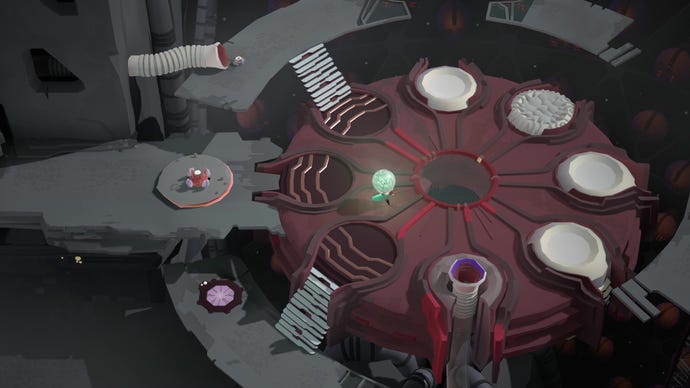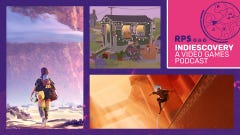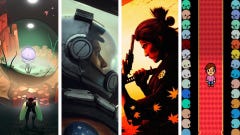The (miniature) making of Cocoon: how to make a complex puzzle game feel easy
From the original prototype to the "loop-free music"
One of the most unnerving things about Geometric Interactive's lush insect puzzler Cocoon is how intuitive it feels. For my money, anyway. The premise is perfectly brain-bending: each world contains or is contained by another world, and you're a beetle who can not only leap between them, but pick one world up and use it as a puzzle prop inside another.
The game doesn't really verbalise any of this: there's no equivalent for Atreus in God Of War: Ragnarok, ostentatiously nudging you towards each solution. And yet somehow, I find myself flowing through Cocoon like I'm being poured out of a bottle, switching scales and putting together the pieces in a way that feels effortful yet graceful, earned yet... eerily frictionless. This is no reflection on my knack for solving puzzles. It's a show of how elegantly the game is made so that while there's difficulty, there's rarely frustration.
That spooky smoothness of navigation and understanding is the result of a lot of hard work at several levels of production, from the setting's careful balance of exotic and functional elements, to smaller technicalities behind the scenes. Asked to pick out a favourite detail from the game, art director Erwin Kho points not to any visible element of Cocoon's Giger-influenced world but to its 'colliders' - aka, invisible shapes that decide where the edges of a game object really lie for the player's purposes, allowing developers to fashion readily interlocking puzzle props from visually busy assets. It's the kind of thing you don't even notice while playing, which is why it makes such a difference.
"I know it doesn't sound glamorous or creative, but we've spent so much time on making them feel great and I do think you experience that, but that most players probably wouldn't even realise it," Kho says. On a similar note, Geometric's founder and game director Jeppe Carlsen points to how the player character's head swivels discreetly towards things you can interact with, guiding you without guiding you. "We even use that to hint at a few puzzle solutions here and there," he says.
One of Geometric's greatest challenges was preserving the simplicity of Cocoon's earliest 2D prototype, which Carlsen and the studio's other founder and composer Jakob Schmid knocked together in three to four months. "I had already been thinking about the mechanics a lot before we began coding, and it was fascinating how much things fell into place once we did," Carlsen recalls. "The prototype contained an hour of challenging puzzle gameplay, and most of the mechanics carried over into the final game in some form - a few puzzles are in fact almost identical.
"Once we later started building beautiful worlds that you immerse yourself in, the biggest gameplay design challenge was how to expand on the simplicity of the initial 2D prototype," he goes on. "It was clear, that we needed to interact with the worlds in more varied and fun ways, so we for example started prototyping how tethered-orbs could be used to pull large biomechanical creatures, and how jump pads could be used to slam dunk an orb into a pipe system from mid-air - satisfying interactions that make you smile and feel more directly connected to the world, while still keeping the focus on orbs."

It was up to Kho as art director to resolve the difference between these later, arcane fixtures and the prototype's clean puzzle concepts. "A lot of the 3D designs were heavily influenced by the prototype's simple geometric shapes, especially in the beginning," he says. "For example, the 3D version of the warp exit portals were diamond-shaped for quite a while, just like in the prototype, and the little triangular flying drones you come across in the game were also triangles in the prototype, just without any legs."
Kho sought to make the prototype's bare silhouettes more involved, without distorting them beyond recognition. In amongst all this, he also had to weave in the backstory, teaching you about the origins of and relationships between Cocoon's nested dimensions without making it an explicit focus. It's quite the balancing act. But the more surprising revelation, for me, is that Cocoon's music is subtly designed to alleviate the feeling of getting stuck on a puzzle. Composed entirely using synthesisers, it's spliced together in response to your behaviour and with a view to avoiding distracting repetition.
"The music playing throughout most of the game is generated in real-time with a set of software synthesizers that I developed specifically for Cocoon," Schmid explains. "This allows for loop-free music during long 'thinking breaks' and allows us to more directly accompany the player's actions by modifying notes and timbre on the fly."

The music being sort of 'without end' reinforces the idea that Cocoon's world doesn't have a maximum extent. In the course of showing that every reality has a reality outside it, the game tees up the old philosophical gambit that our universe must be infinite, because after all, if our universe does have some kind of outermost boundary, there must be something beyond that boundary, and that something must be part of the universe too - repeat ad nauseum.
Every world is a world-within, in other words, and I'm disconcerted to learn that I've been 'hearing' that absence of outer limits as I scuttle around Cocoon's mesmerising landscapes, unburdened for all the weight of the reality on my back. It puts me in mind of Yedoma Globula, which is some of the highest praise I can bestow. "The idea of exploring a structure of worlds within worlds is the sole reason we are making this game to begin with," Carlsen notes. "It was the seed that started it all and all other design decisions were made to support this core gameplay concept."
Thanks to our reviews editor Ed Thorn for conducting the interview that spawned this feature. His Cocoon review has more on why this is one of the best puzzle games we've played all year.















